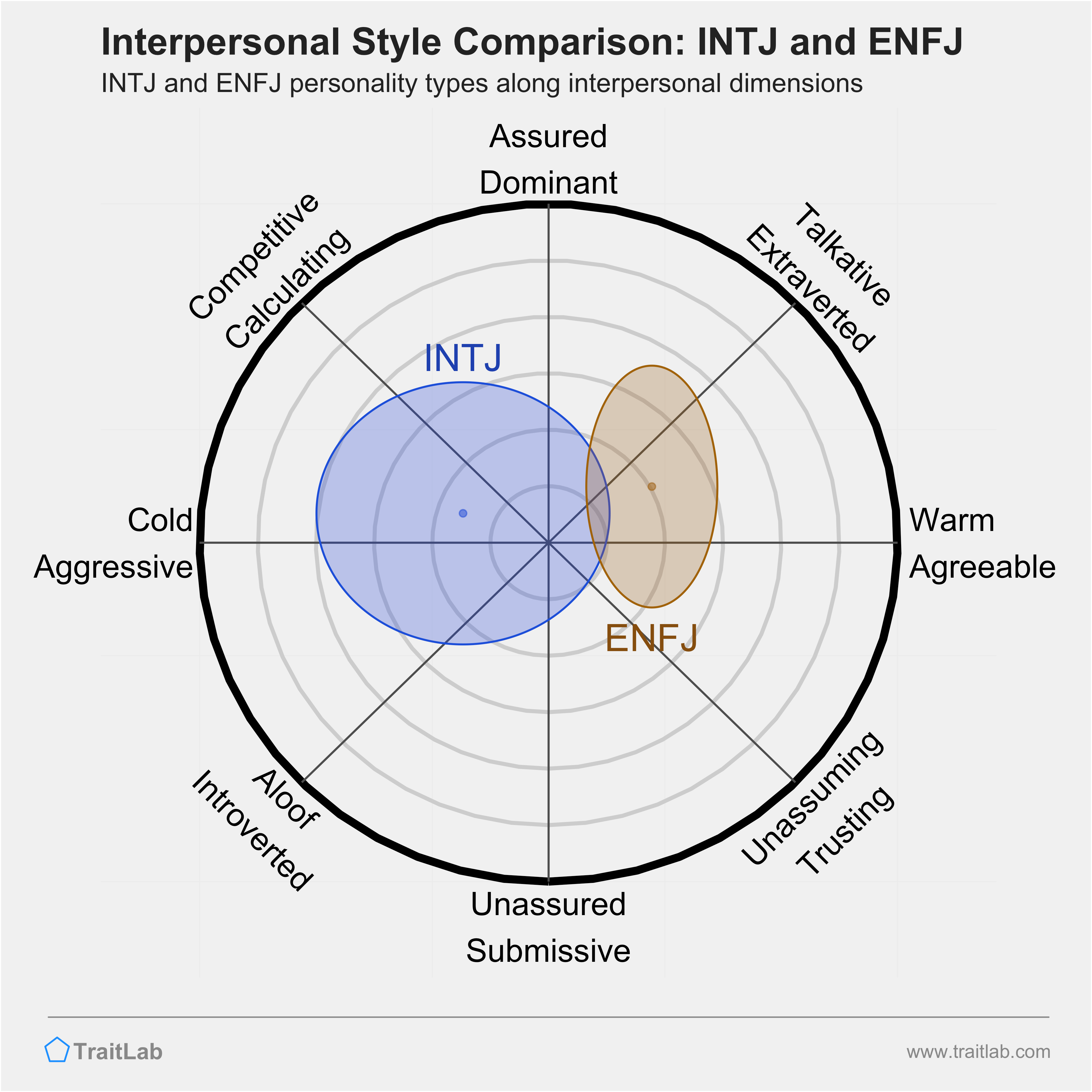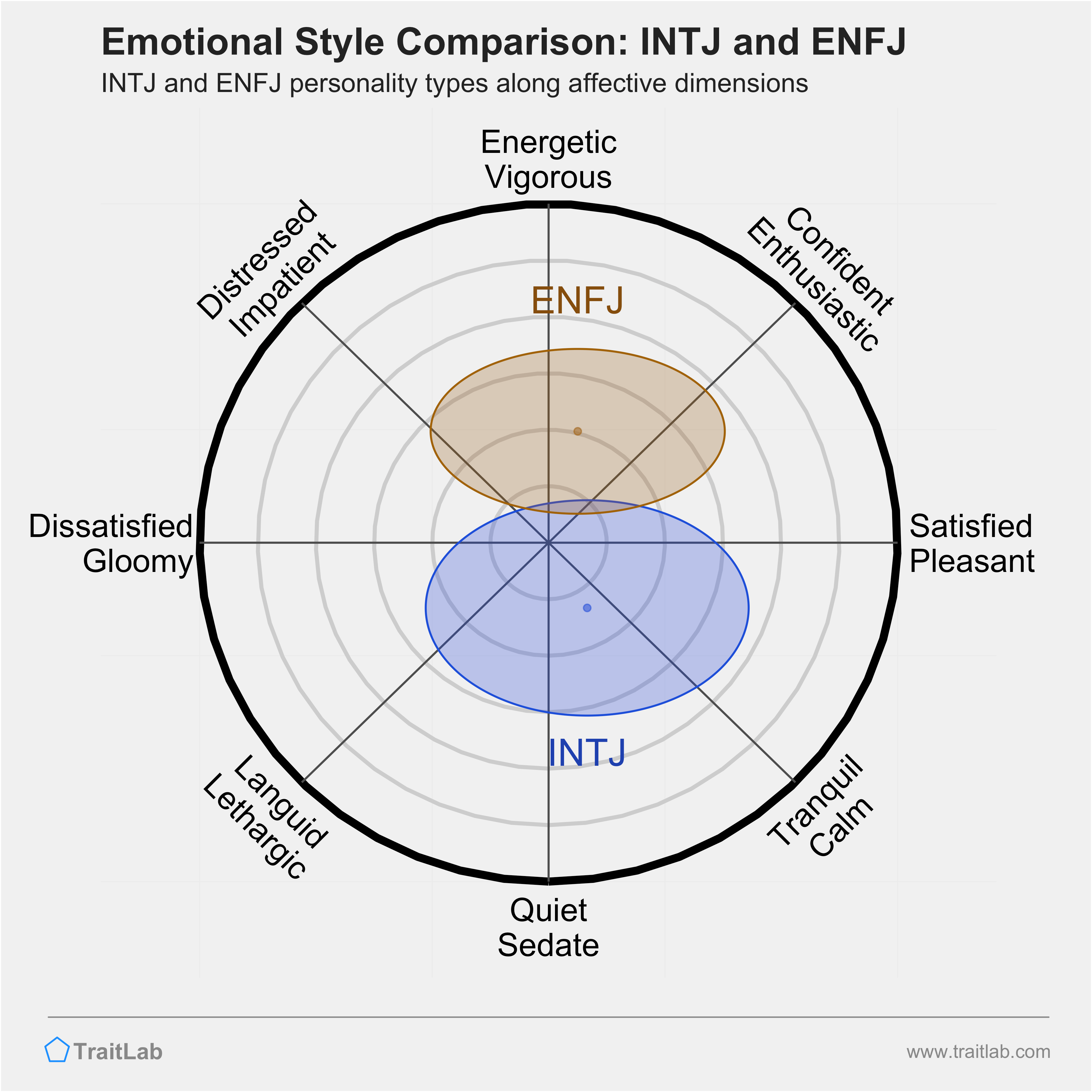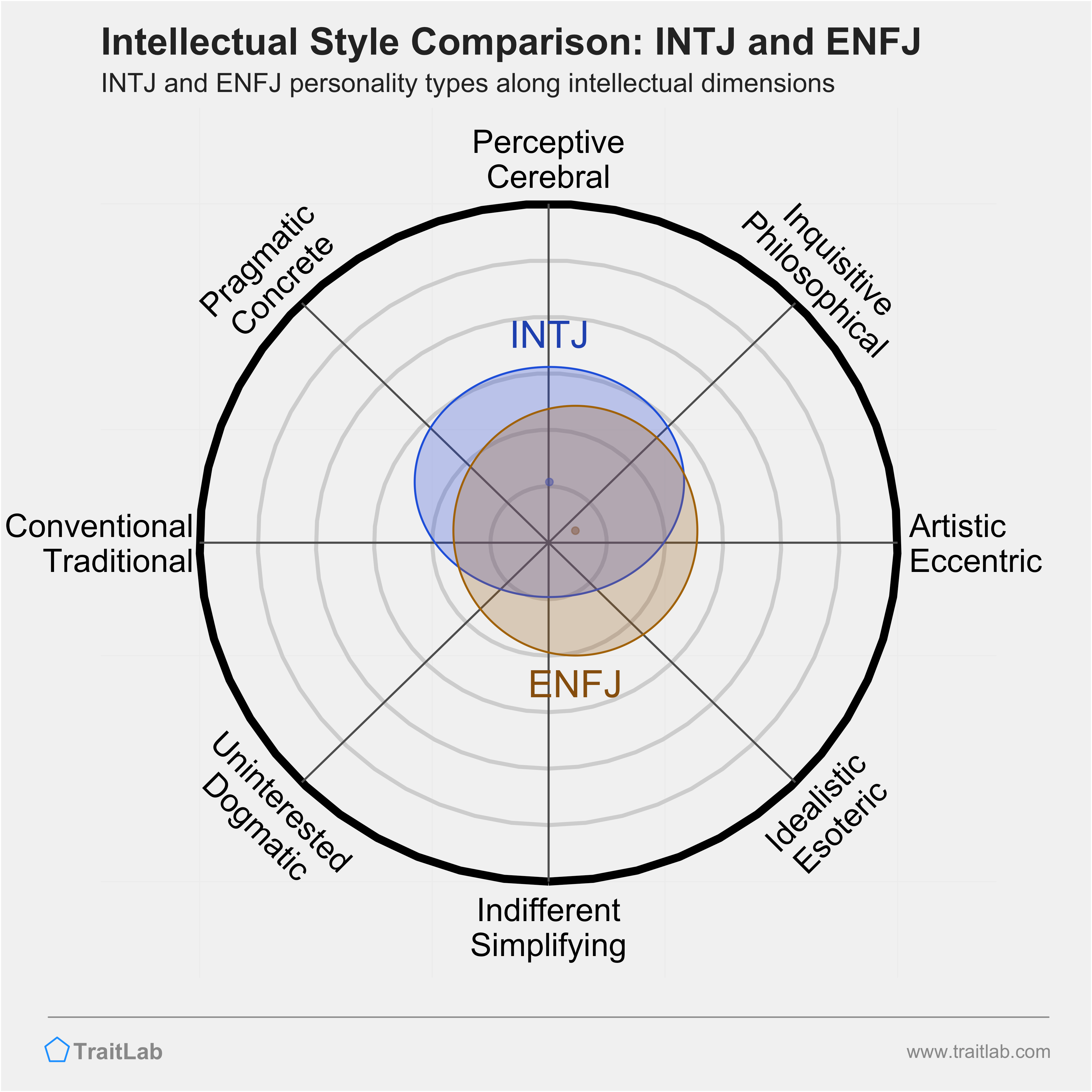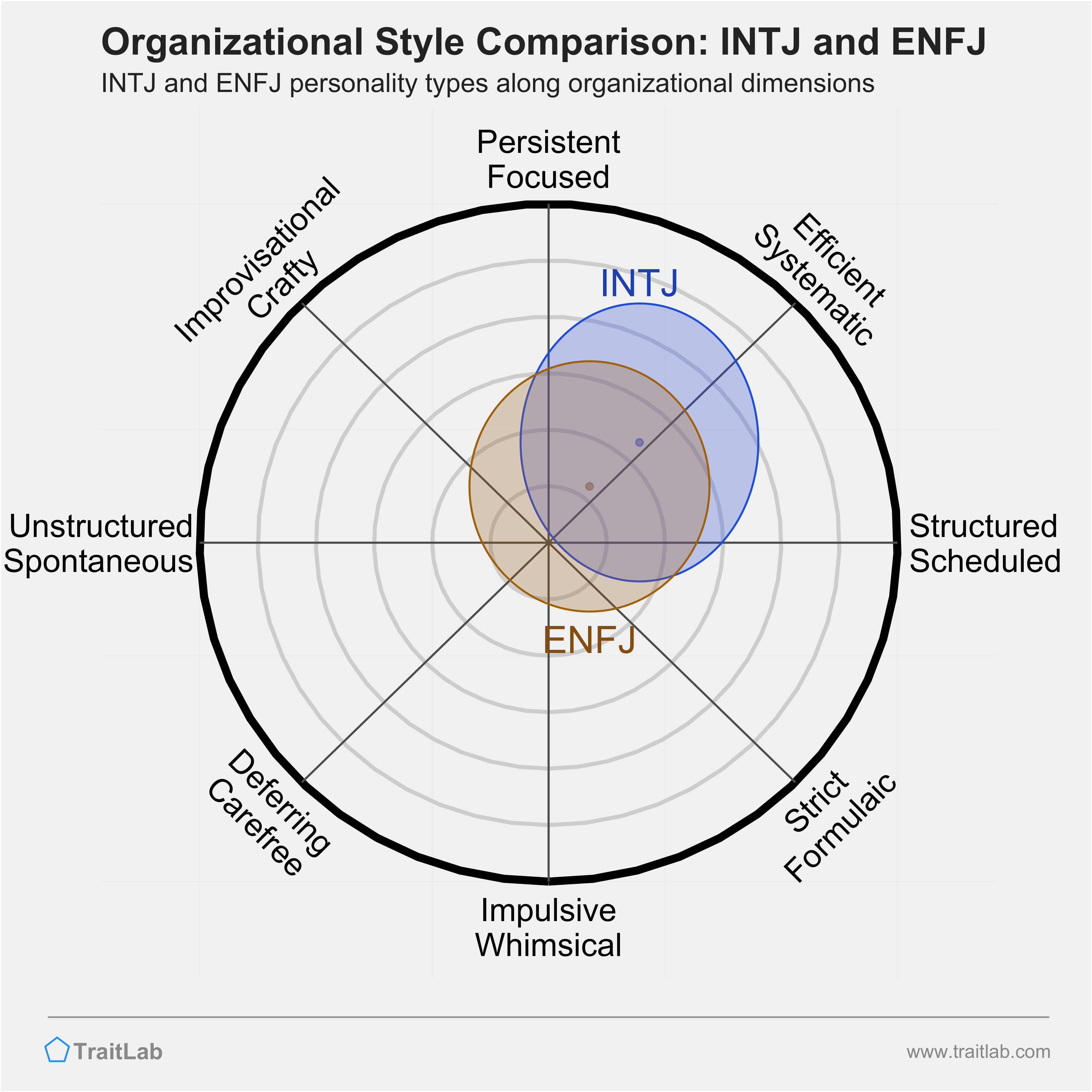How compatible are INTJ and ENFJ patterns of communicating, thinking, and working?
Reading time: 5 minutes

Gregory Park, Ph.D.
Author
In this article, you’ll find a comparison of INTJs and ENFJs across five important personality domains: Interpersonal/Communication Style, Emotional Style, Intellectual Style, and Organizational Style.
One important note: the following comparisons cannot be made simply by comparing the cognitive functions (letters) of each personality type.
For this analysis, TraitLab gathered data about personality traits from thousands of participants who identified themselves as a particular type in the 16 Personality or Myers-Briggs framework.
The comparisons here show the average similarities and differences between INTJs and ENFJs. However, remember that all personality types are oversimplifications. For an assessment of your unique position in these areas, you’ll need a personalized assessment that doesn’t rely on personality types.
Jump to any section with the links below.

Do you know your personality type?
Learn about your type and so much more with TraitLab's comprehensive personality assessment.
Your particular style of communicating and interacting with others can be described fairly well by two dimensions: assertiveness and warmth.
Assertiveness describes your tendency to assert yourself, lead, and influence others in social situations, while warmth describes your tendencies to empathize and put others’ needs ahead of your own.
People with the same personality type often share some similarities in assertiveness and warmth. In the graph below, you can see where most INTJs and most ENFJs fall along both of these dimensions.
First, take a look at where people in each type, on average, fall in this interpersonal space.

INTJs are forthright, firm, and speak their mind directly. At their best, they are fiercely independent and unaffected by the thoughts and opinions of others. INTJs may be harsh, frank, or insensitive in their criticism of others. At their worst, they can be overly aggressive and too eager to fight and argue with others.
ENFJs often support, openly sympathize, and actively offer help to others At their best, they are gentle sympathizers, who are easily trusted and accepted. ENFJs may be overly revealing and have difficulty being alone. At their worst, they can require too much attention and admiration from others and be excessively involved in the affairs of others.
As an INTJ, one notable difference between you and most ENFJs is in your interpersonal warmth. You are likely on the colder, more combative side of the spectrum. Compared to you and other INTJs, ENFJs’ can sometimes feel overly focused on feelings and intentions, rather than the facts of the matter at hand.
However, you and most ENFJs both tend to be more assertive and dominant in social situations. You are both managing, directing, and leading others, and feel comfortable taking the lead. This may lead you to butt heads with some ENFJs, because at times, you can both be domineering or overly direct.
Another characteristic of your personality is your emotional style — your tendencies towards different kinds of moods. There are two dimensions that influence emotional style: arousal and valence.
Arousal describes your relative energy level across different situations. Those with high baseline levels of arousal tend to be generally more alert, active, and engaged, while those with a lower baseline are more reserved, subdued, and inhibited.
Valence describes whether these moods tend to be positive (pleasant) or negative (unpleasant). People with a more positively valenced style are more likely to experience emotions like joy, enthusiasm, satisfaction, and serenity. People with a more negatively valenced style are more likely to experience sadness, frustration, dissatisfaction, and anxiety.
The graph below shows where each type, on average, usually sits in this emotional space.

INTJs tend to be reserved, laid-back, and content. They often see the glass as half-full, confident that things will eventually work out for the best. INTJs typically respond to challenges with quiet optimism and rarely become overwhelmed when things get difficult. When their efforts fail, they calmly dust themselves off and try again.
ENFJs tend to be energetic and enthusiastic across most situations. They take on new challenges with excitement, confidence, and a sense of adventure. ENFJs are usually more optimistic than most people, and they generally feel like they can handle what life throws at them.
As with most INTJs, you tend to be more reserved, inhibited, and quiet than most ENFJs. Between the two of you, you are more likely to need more personal space, solitude, and time to decompress. While you can tolerate long periods of calm and quiet, your ENFJ counterparts often craves more engagement and excitement. In the best cases, an ENFJ can pull you out of your comfort zone and get you out into the world, while your quiet nature helps to balance out their intensity.
However, both INTJs and ENFJs are generally more positive than negative. They are more likely to express enthusiasm, satisfaction, happiness, and other positive emotions across most situations. Like everyone else, they occasionally experience negative emotions like sadness, anxiety, and anger, but they soon return to their usual pleasant state. Together, INTJs and ENFJs tend to share an optimistic outlook and a resilience to stress.
Your intellectual style describes how you receive, process, and pursue different kinds of information. Differences in intellectual style are captured well by two dimensions: ideas and aesthetics.
Ideas describes your appetite for new information and your interest in complex, challenging material. People high on the ideas dimension have an appreciation for complexity and technical details. People lower on ideas are less interested in learning for learning’s sake, and they prefer to simplify complex topics down to the essential details.
Aesthetics captures your relative interest and sensitivity to aesthetic information and its emotional impact. People higher on the aesthetics dimension usually have strong artistic interests and a deep appreciation for beauty in many forms. Those lower on aesthetics tend to value practical application over artistic merit and usually adhere to more conventional standards of beauty.
In the graph below, you’ll see where INTJs and ENFJs, on average, fall in this intellectual space.

Most INTJs and ENFJs overlap heavily in their intellectual style.
INTJs and ENFJs tend to be deep thinkers — bright, curious, and philosophical. They are highly receptive to new ideas and drawn to complex, abstract concepts. INTJs and ENFJs enjoy taking in large amounts of information and typically have one or more creative outlets.
As an INTJ, you and many ENFJs share a love of learning new, challenging ideas. You both appreciate complexity and nuance, and the two of you can spend hours discussing and debating a wide range of topics. When you are together, you often elevate the conversation to a more theoretical, philosophical level.
Likewise, both INTJs and ENFJs share a deep appreciation for beauty in the natural and artistic world. Both of you can easily become absorbed in aesthetic experiences and overcome with a sense of awe and wonder. The two of you can find common ground in your love of creative expression and unconventional approaches to life’s challenges.
Your organizational style describes your habits around organization and planning. Your organizational style influences how you structure your time and physical space. Differences in organizational style fall along two dimensions: industriousness and orderliness.
Industriousness describes your persistence, need for achievement, and intensity of focus. People higher on industriousness usually organize their behavior around a few important long-term goals. People lower on industriousness are usually more focused on the present and will more easily change their focus when new opportunities appear.
Orderliness describes your need for regularity, order, and structure in your environment. People higher on orderliness prefer tidy, organized physical spaces, detailed schedules, and reliable routines. People lower on orderliness can tolerate more disorganization and prefer a more spontaneous, unstructured approach.
The graph below shows the average position of INTJs and ENFJs along these dimensions of organizational style.

Most INTJs and ENFJs share a similar organizational style.
INTJs and ENFJs are usually systematic and highly organized. They like setting big, long-term goals and then creating detailed plans to accomplish them. INTJs and ENFJs are generally good at ignoring distractions and making steady progress through consistent routines and habits.
As an INTJ, you and most ENFJs share a natural drive to achieve and perform at a high level. Both of you enjoy setting goals and pushing yourselves to accomplish them, and you likely share an interest in self-improvement and productivity strategies. As a result, you and your ENFJ counterpart can fuel each other’s ambition and keep each other accountable as you work towards your long-term goals. However, between the two of you, nobody usually reminds you to slow down and enjoy the present.
Similarly, INTJs and ENFJs tend to be neat, tidy, and organized. You both rely on high amounts of structure and routine and compared to most people, you have lower tolerances for messiness and disorder. With a few exceptions, both of you stick closely to most social conventions and feel uncomfortable straying from them.
Most people have complex personalities and don’t fall into a single personality type.
With TraitLab’s comprehensive analyses of your traits, strengths, and interests, you can see how your personality compares to all 16 types. Start building your personality profile by creating a free account today.
For comparisons between INTJs and other types from the 16 Personality typology, visit any of the type pairings below:
For comparisons between INTJs and other Enneagram types, visit any of the type pairings below: